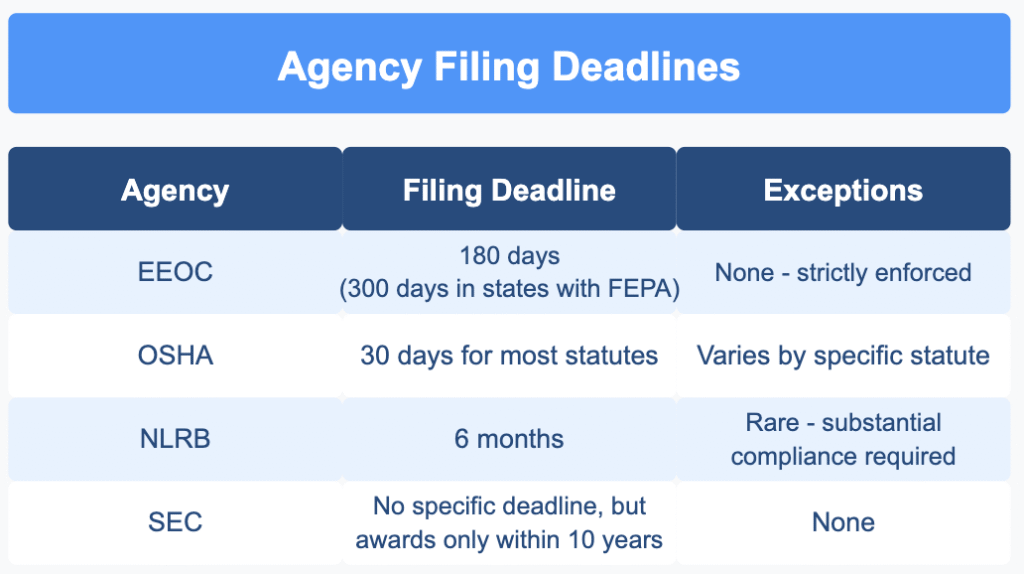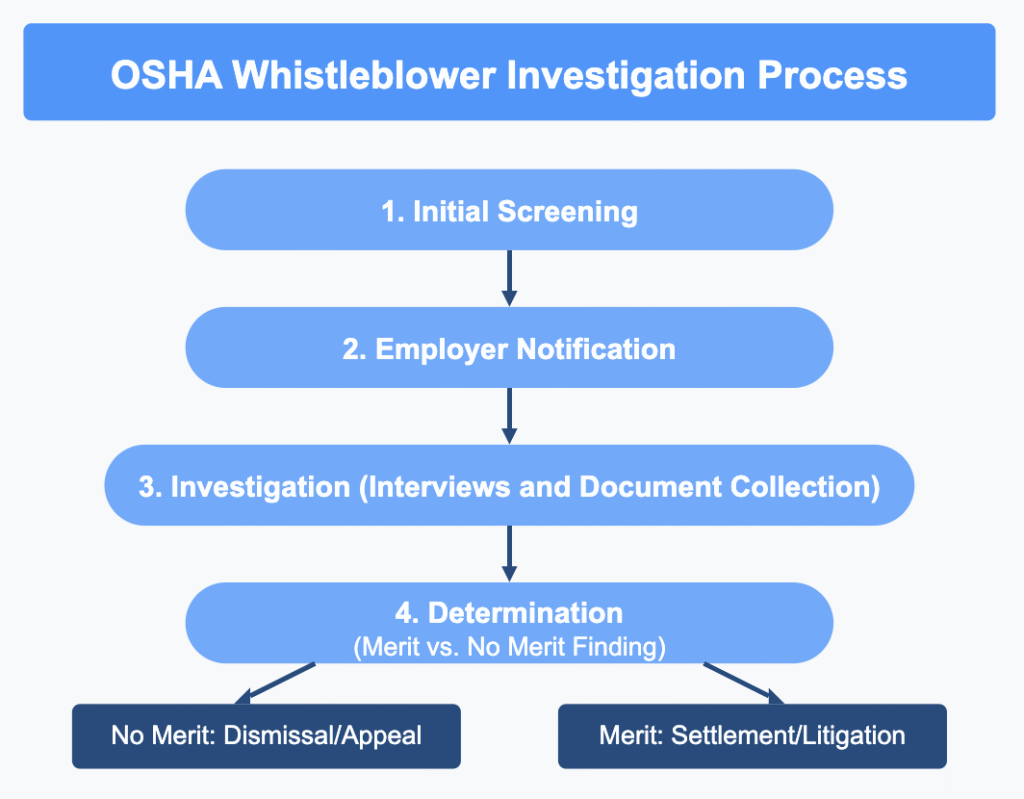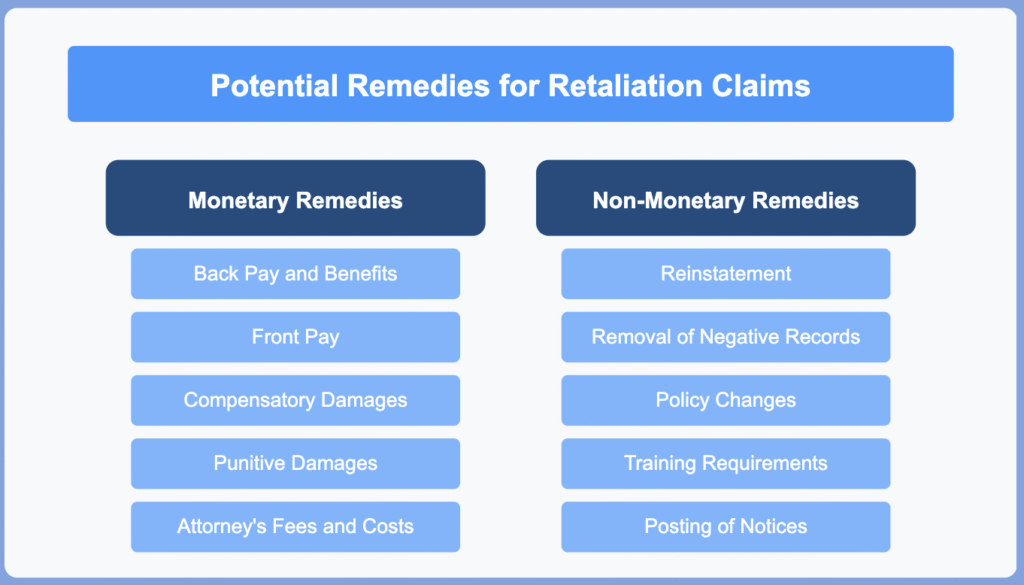When you’ve experienced workplace retaliation after reporting discrimination, harassment, or other violations, knowing exactly how to seek help from government agencies can make the difference between a successful claim and a missed opportunity. While internal reporting is often the first step, government agencies provide critical protections and remedies when your employer fails to address retaliation properly.
This guide walks you through exactly which agencies handle retaliation claims, how to file effective complaints, what deadlines you must meet, and what to expect throughout the process. We’ve helped hundreds of clients navigate these systems successfully, and these practical insights will help you protect your rights effectively.
Disclaimer: This article provides general information for informational purposes only and should not be considered a substitute for legal advice. It is essential to consult with an experienced employment lawyer at our law firm to discuss the specific facts of your case and understand your legal rights and options. This information does not create an attorney-client relationship.
Which Government Agency Should Handle Your Retaliation Complaint?
Choosing the right agency is your first critical decision. Different agencies handle different types of retaliation claims, and filing with the wrong one can waste precious time against strict deadlines.
Here’s a breakdown of the major agencies and what they cover:
Equal Employment Opportunity Commission (EEOC)
The EEOC handles retaliation connected to discrimination or harassment based on:
- Race, color, national origin
- Sex (including pregnancy, sexual orientation, and gender identity)
- Religion
- Age (40 or older)
- Disability
- Genetic information
If you faced retaliation after reporting discrimination or harassment based on any of these characteristics, the EEOC is typically your primary agency for filing complaints.
Department of Labor (DOL) Agencies
Several agencies within the Department of Labor handle specialized retaliation claims:
Occupational Safety and Health Administration (OSHA)
- Workplace safety and health complaints
- Environmental violations
- Consumer product safety
- Food safety
- Securities fraud
- Violations of 25+ whistleblower statutes
- Minimum wage violations
- Overtime violations
- Family and Medical Leave Act (FMLA) issues
- Child labor violations
Office of Federal Contract Compliance Programs (OFCCP)
- Discrimination by federal contractors and subcontractors
National Labor Relations Board (NLRB)
The NLRB handles retaliation related to:
- Organizing or joining a union
- Discussing workplace conditions with coworkers
- Engaging in concerted activities for mutual benefit
Securities and Exchange Commission (SEC)
The SEC’s Office of the Whistleblower handles retaliation after reporting:
- Securities law violations
- Accounting fraud
- Bribery
- Internal control issues
Filing Deadlines: Don’t Miss Your Window of Opportunity
Missing a filing deadline can permanently eliminate your right to pursue a retaliation claim. These deadlines are strict and non-negotiable in most cases.

I’ve seen many strong retaliation cases fail solely because the employee missed a filing deadline by just a few days. Calendar these deadlines immediately if you’re considering filing a complaint.
Step-by-Step: Filing an EEOC Retaliation Complaint
Since the EEOC handles the majority of workplace retaliation claims, here’s exactly how to navigate their process:
1. Prepare Your Information
Before contacting the EEOC, gather:
- Your contact information
- Your employer’s name, address, phone number
- Approximate number of employees
- Brief description of the discrimination/harassment you reported
- Brief description of the retaliatory actions
- Dates of key events
- Names and contact information for witnesses
- Any supporting documents (emails, performance reviews, etc.)
2. Initiate Contact
You can file with the EEOC in several ways:
- Online through the EEOC Public Portal
- In-person at your nearest EEOC office
- By mail with a letter including all relevant information
- By phone (though you’ll eventually need to complete additional forms)
For most clients, we recommend starting online, as it provides immediate confirmation of your submission.
3. Participate in the Intake Interview
After initial contact, you’ll have an intake interview with an EEOC staff member who will:
- Review your information
- Determine if your situation falls under EEOC jurisdiction
- Help you complete the formal charge document
- Explain the process and answer your questions
Be specific about both the protected activity (what you reported) and the retaliatory actions. For example, instead of saying “I was treated unfairly after complaining,” specify “After reporting sexual harassment on March 15, 2023, my supervisor excluded me from three critical client meetings on March 18, 22, and 29, reassigned my major accounts to junior colleagues on April 2, and issued a negative performance review on April 10 despite my consistently positive reviews for the past five years.”
4. File the Formal Charge
After the intake interview, you’ll receive a charge document to review, sign, and return. Review this carefully to ensure all facts are accurate. Once filed, the EEOC will notify your employer about the charge within 10 days.
5. Agency Investigation
The EEOC investigation may include:
- Requests for written responses from your employer
- On-site visits
- Witness interviews
- Document requests
- Mediation (if both parties agree)
The investigation timeframe varies significantly, from a few months to over a year in complex cases.
OSHA Whistleblower Complaints: Special Considerations
OSHA’s Whistleblower Protection Program deserves special attention because it covers so many different statutes related to whistleblower retaliation. Here’s what you need to know about this process:
Filing Options
You can file an OSHA whistleblower complaint:
- Online through OSHA’s Whistleblower Portal
- By phone to 1-800-321-OSHA
- By fax or mail to your local OSHA office
- In person at your local OSHA office
What to Include
Your OSHA complaint should include:
- Your name, address, and phone number
- Name, address, and phone number of the person who experienced retaliation
- Name, address, and phone number of the employer
- Name of supervisor or manager
- Your job title and responsibilities
- As many details as possible about your safety/health concern or other protected activity
- Date you engaged in protected activity
- How your employer learned about your protected activity
- Adverse actions taken against you and when
- Why you believe the adverse action was connected to your protected activity
- Names of witnesses
- Whether you’ve filed complaints with other agencies
Investigation Process
Once you file, OSHA follows this process:

- Initial Screening: OSHA reviews your complaint to determine if it meets the basic requirements for investigation.
- Notification: If accepted, OSHA notifies your employer and requests a response.
- Investigation: OSHA interviews witnesses and collects evidence. This process can take several months.
- Determination: OSHA decides if there is reasonable cause to believe retaliation occurred.
- Resolution: If OSHA finds reasonable cause, they’ll attempt to negotiate a settlement. If unsuccessful, OSHA may pursue legal action against your employer.
One of our clients, a warehouse safety manager, reported dangerous forklift operating conditions to OSHA and was subsequently demoted. When he filed a whistleblower complaint with OSHA, the agency’s investigation revealed emails showing managers discussing how to “deal with the troublemaker.” This evidence helped secure a settlement that included reinstatement, back pay, and implementation of the safety measures he had originally recommended.
Agency Investigation: What to Expect and How to Help Your Case
Once you’ve filed your complaint, you can strengthen your position during the investigation:
Do’s and Don’ts During Agency Investigations
Do | Don’t |
Respond promptly to all agency requests | Discuss your case on social media |
Provide organized, relevant documentation | Contact witnesses to influence their statements |
Continue documenting any ongoing retaliation | Miss deadlines for submitting requested information |
Update your contact information if it changes | Exaggerate or embellish facts |
Consider getting legal representation | Sign anything from your employer without review |
Preserve all evidence, including electronic | Quit your job without consulting an attorney |
Working with Agency Investigators
Agency investigators handle numerous cases simultaneously. Make their job easier (and potentially get better results) by:
- Organizing your evidence chronologically. Create a timeline connecting your protected activity to the retaliatory actions.
- Identifying specific witnesses. Provide names, contact information, and what information each witness can provide.
- Submitting concise written statements. Clearly explain key events without unnecessary details.
- Remaining professional in all communications. Emotional outbursts can undermine your credibility.
- Following up appropriately. Monthly status inquiries are reasonable; weekly calls are not.
Potential Outcomes and Remedies
Agency findings can vary significantly. Here are possible outcomes and available remedies:
EEOC Outcomes
If the EEOC finds “reasonable cause” that retaliation occurred, they will attempt conciliation (settlement negotiations). If unsuccessful, the EEOC may:
- File a lawsuit on your behalf (rare)
- Issue a “right to sue” letter allowing you to file your own lawsuit
Even if the EEOC finds “no reasonable cause,” they will still issue a right to sue letter, preserving your right to pursue legal action privately.
Remedies Available Through Agency Action
Agencies can help secure various remedies:
- Reinstatement to your former position
- Back pay for lost wages and benefits
- Front pay when reinstatement isn’t feasible
- Compensatory damages for emotional distress
- Punitive damages in cases of intentional violations
- Injunctive relief (court orders requiring specific actions)
- Policy changes to prevent future violations
- Training requirements for managers and staff
- Posting notices about employees’ rights
- Removal of negative information from personnel files

A recent client, a nursing supervisor who reported patient safety violations, faced retaliation through a sudden shift change that conflicted with her childcare arrangements. After filing with OSHA, the investigation revealed that no other supervisors had experienced similar schedule changes. The complaint resulted in reinstatement to her original schedule, compensation for childcare expenses incurred during the retaliatory period, and implementation of a new scheduling policy requiring two weeks’ notice for non-emergency schedule changes.
When to Consider Multiple Agency Filings
In some cases, filing with multiple agencies makes strategic sense:
Cross-Filing Considerations
- Some retaliation situations fall under multiple agency jurisdictions
- Agencies may have work-sharing agreements that allow cross-filing
- Different agencies offer different remedies and timelines
- The strength of evidence may vary under different legal standards
For example, if you were fired after reporting both race discrimination and wage violations under the False Claims Act, filing with both the EEOC and WHD might be appropriate. However, this strategy can complicate your case and requires careful coordination.
When Agency Filing Isn't Enough: Next Steps
Agency action doesn’t always resolve retaliation cases effectively. Consider these additional options:
Direct Legal Action
In many cases, you can pursue legal action after:
- Receiving a “right to sue” letter from the EEOC
- Waiting 180 days after filing if no determination has been made
- Exhausting administrative remedies through other agencies
Benefits of Legal Representation
While you can navigate agency processes alone, attorney representation offers significant advantages:
- Strategic selection of appropriate agencies
- Professionally drafted complaints that highlight key legal elements
- Effective communication with investigators
- Evaluation of settlement offers
- Coordination between multiple agency filings
- Preparation for potential litigation if agency action fails
Our experience representing retaliation victims before these agencies has shown that effective legal advocacy often leads to more thorough investigations and better outcomes.
Taking Action: Your Next Steps
If you’re facing workplace retaliation after reporting discrimination, harassment, or other violations, take these steps immediately:
- Document everything related to both your protected activity and the retaliation
- Identify the appropriate agency based on the type of retaliation
- Check filing deadlines and mark your calendar
- Gather supporting evidence including emails, performance reviews, witness information
- Consider consulting an employment attorney before filing
- Prepare your complaint following the specific agency’s requirements
- Follow up appropriately during the investigation
- Preserve your right to sue by requesting necessary documentation
At Nisar Law, we have extensive experience guiding clients through agency complaint processes for workplace retaliation. Our attorneys can help you navigate these complex systems, prepare compelling complaints, and pursue all available remedies. Contact us for a confidential consultation to discuss your specific situation and develop an effective strategy for addressing workplace retaliation.
Related Resources
- Protected Activities: What Actions Are Legally Safeguarded
- Forms of Retaliation: Beyond Termination
- Temporal Proximity: Linking Protected Activity to Adverse Action
- Documenting Retaliation: Creating a Paper Trail
- Whistleblower Retaliation: Special Protections
- Damages Available in Retaliation Cases
- Title IX Protections in Educational Institutions
- Faculty Rights and Academic Freedom
- Discrimination in Higher Education Settings


